Silver Taiga Foundation’s director Yury Pautov took part in the field tour entitled “Sustainable Forestry – a Dialogue between Canada and other Countries” where experts from Russia and other forested regions learned about the experience of forestry landscape planning at Alberta’s lowland landscapes.
The workshop was held as part of the preparation for the FSC General Assembly that took place from 8 to 13 October in Vancouver, Canada. It was facilitated by FSC Canada and one of the leading North American forestry companies Alberta-Pacific Forest Industries (Al-Pac), as well as by Boreal Forest Platform, an independent platform for free discussion in the field of sustainable forestry, one of initiators of which was the Silver Taiga Foundation.
“To my mind, the workshop was useful both for Russian participants and for representatives of other countries”, Yury Pautov says. “Through observing the way a real FSC certified company operates we saw how you can combine a profitable business with environmental protection and community support in very similar economic and climatic conditions. Аl-Pac leases 7.5 m ha of forested land, with two thirds of it being wetlands and low productive areas. In such conditions there are also no roads, so 75 percent of wood is harvested and hauled in winter, as construction of earth roads at swamps is of no economic benefit. In addition, the biggest part of the leased area is located in the transition zone between boreal softwood forest and prairie dominated by hardwood species, particularly by aspen. And it is aspen that serves as the target species the company focuses on. It is the same aspen as in Russia – low quality, rotten aspen! The average transportation distance is over 200 km. Nevertheless, the company is profitable, it uses up-to-date cutting and road construction technologies. The key product is pulp and ethanol. While softwood species are sold to sawmills…
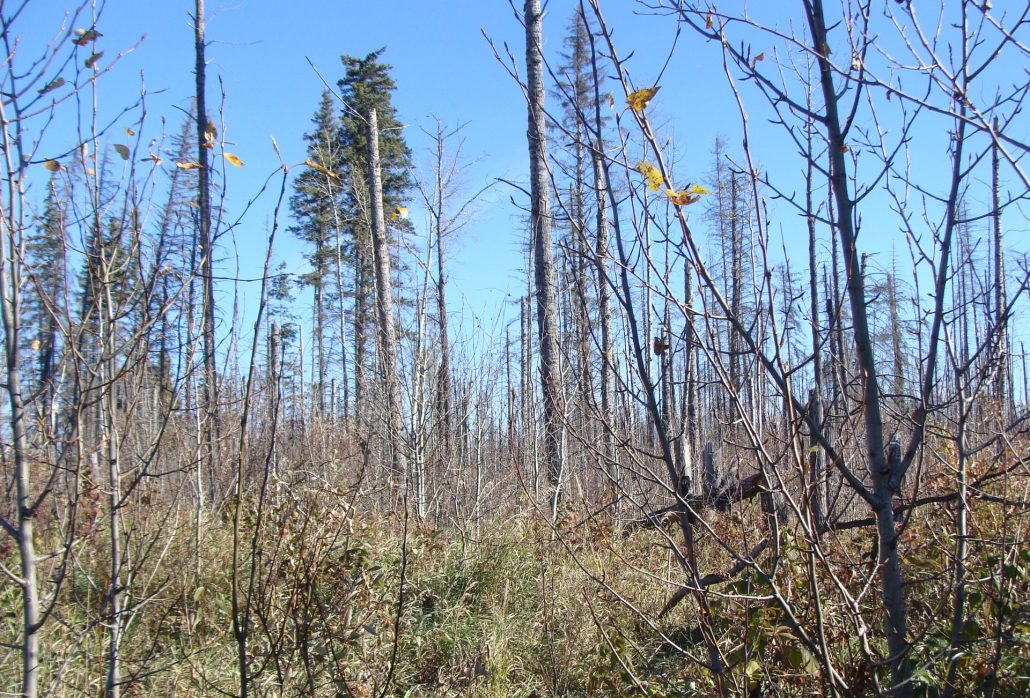
Young aspen forest at the area which was burnt by the fire 9 years ago
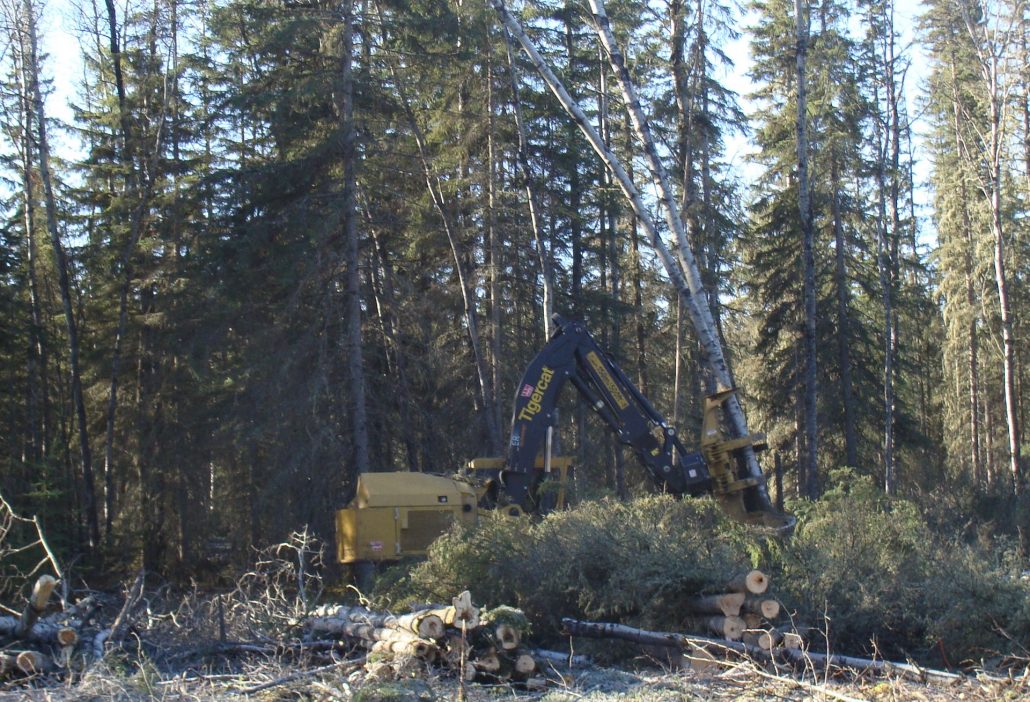
Tigercat harvester can cut and pile several trees at once to facilitate subsequent skidding
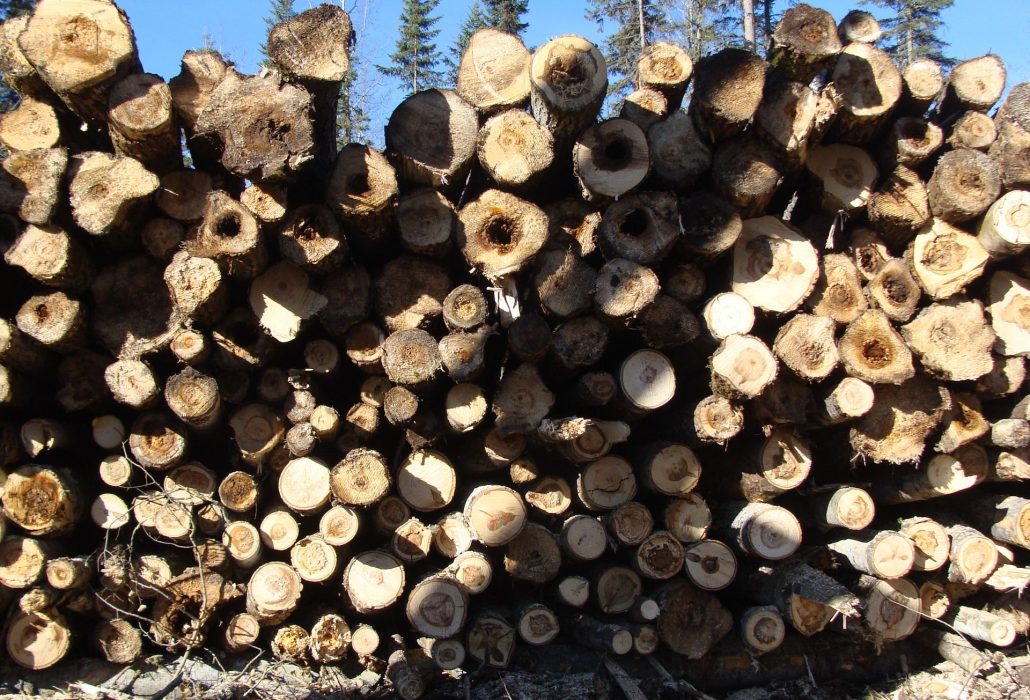
Pile of aspen logs ready to be loaded onto trucks
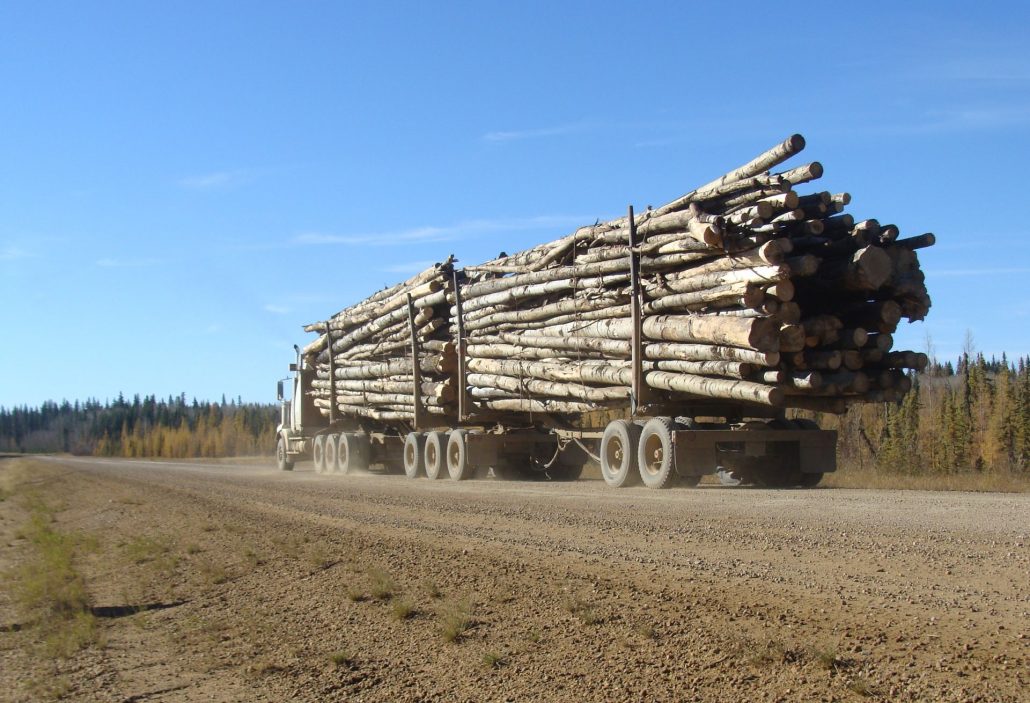
Average transportation distance to the pulp mill is 250 km
According to Yury Pautov, what is known in Russia to be clear cutting isn’t practiced there. Precisely detailed laser ground survey able to register all properties of the landscape is used for forestry planning. Natural history-based “turnover” of forest fires is 60-80 years, according to the company managers. Cutting imitates natural fire dynamics. It is clear that fire doesn’t burn everything, but only the most well drained parts of landscape, so harvesting is planned with this regard. The average size of one logging plot may amount to 2 thousand ha, but only 20-30 percent of the area may be cut. Specially trained teams of delineation experts use space images, aerial photography and laser survey data to draw the borders of the natural fire. Within these borders they mark the boundaries of clear cutting area, plan forest roads and cutting areas adjacent to them, logways, etc. This is necessary, because the mature forest at the area which burnt 60 years ago is similar age. Thus they imitate fire impact by means of logging. At the same time, they preserve biotopes and old trees which remained intact during the last fire for some reasons.
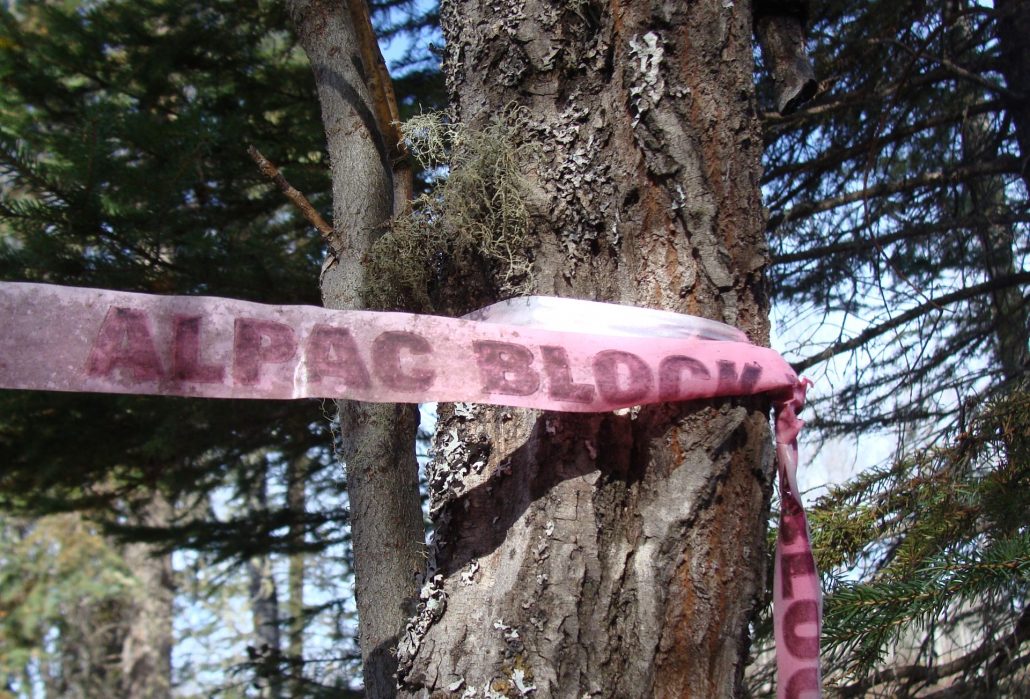
Boundaries of clear cutting areas and their exact GPS coordinates are marked on process sheets and indicated by coloured tape in kind
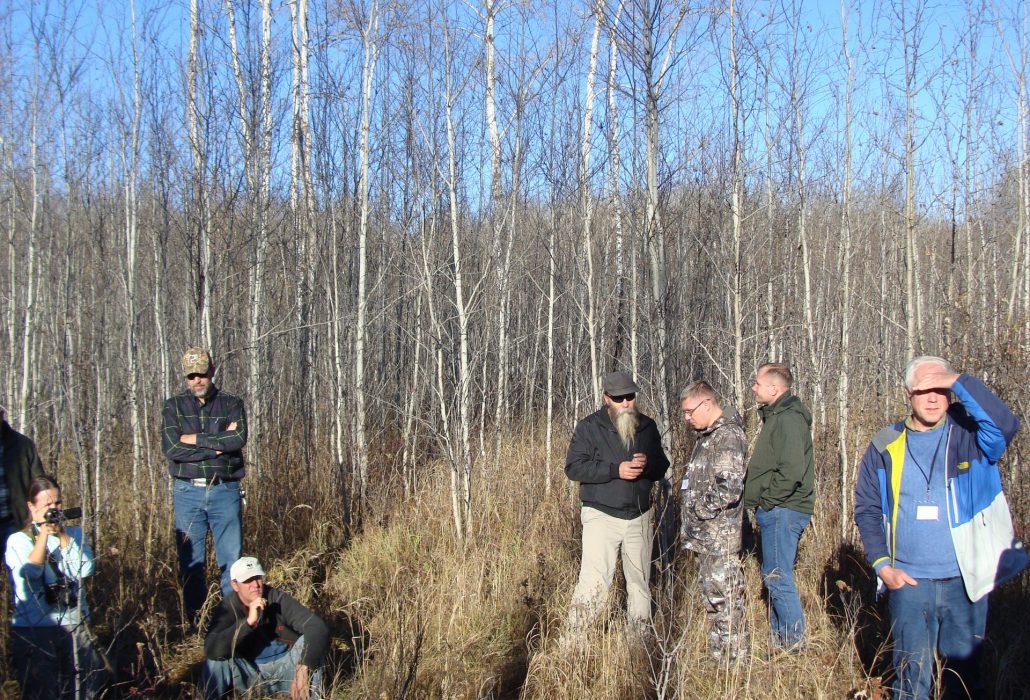
Workshop participants at the area cut 8 years ago
The landscape in this area is flat and swampy, and even minor lowlands are covered with wetlands, which on the one hand are significant from the biological and environmental points of view, and on the other hand are inefficient for harvesting, so the company takes this feature in account and maintains the hydrological network of the area by building bridge crossings over minor streams and hollows and conserving water protection zones along streams and wetlands.
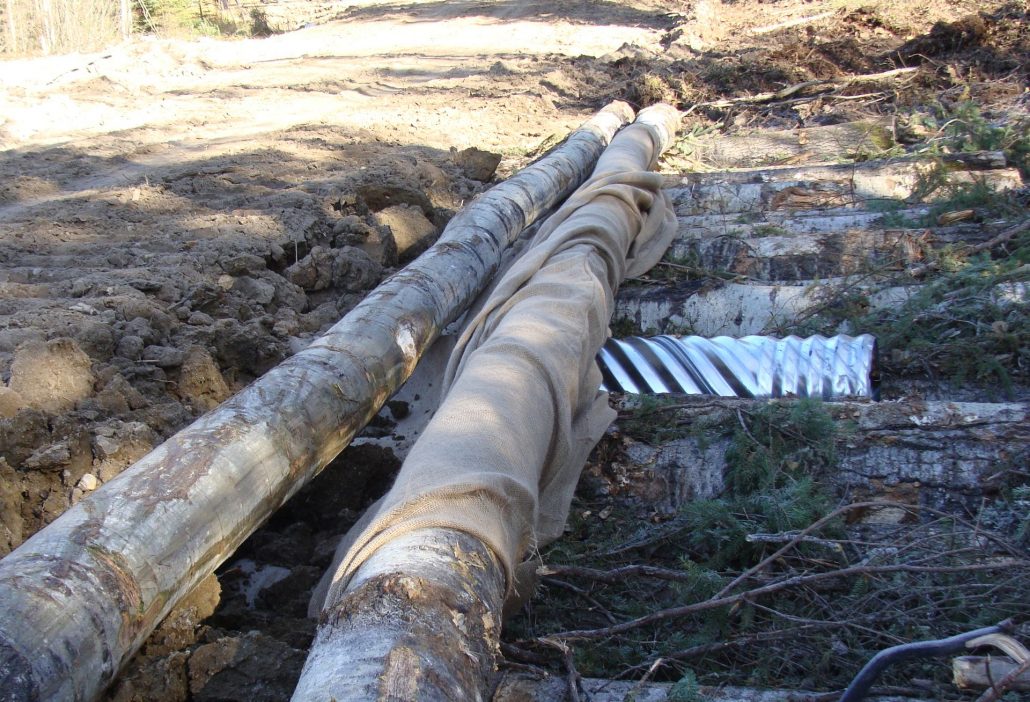
Temporary bridge crossings over streams and hollows is a mandatory condition for forest cutting
Why is harvesting still cost effective with such an approach to logging planning (when only 20-30 percent of the area is cut and mostly unmarketable aspen is obtained)?
“Canada’s advantage in this case is that the natural use rules, as well as forest use regulations, are defined not on the federal level as in our country, but on the province level,” Yury Pautov answers. “It allows taking all social, economic and landscape properties of the region into account. Moreover, the rent is paid not to the federal center, but to the province government, so it is the local government that defines the rules of lease and cutting. In our country, as is known, the rules of the game are defined by federal officials who fail to understand regional peculiarities, or distinctive features of landscapes of different areas… A forest user is left with no options to apply any justified or rational approach to cutting, which should be different in different situations.
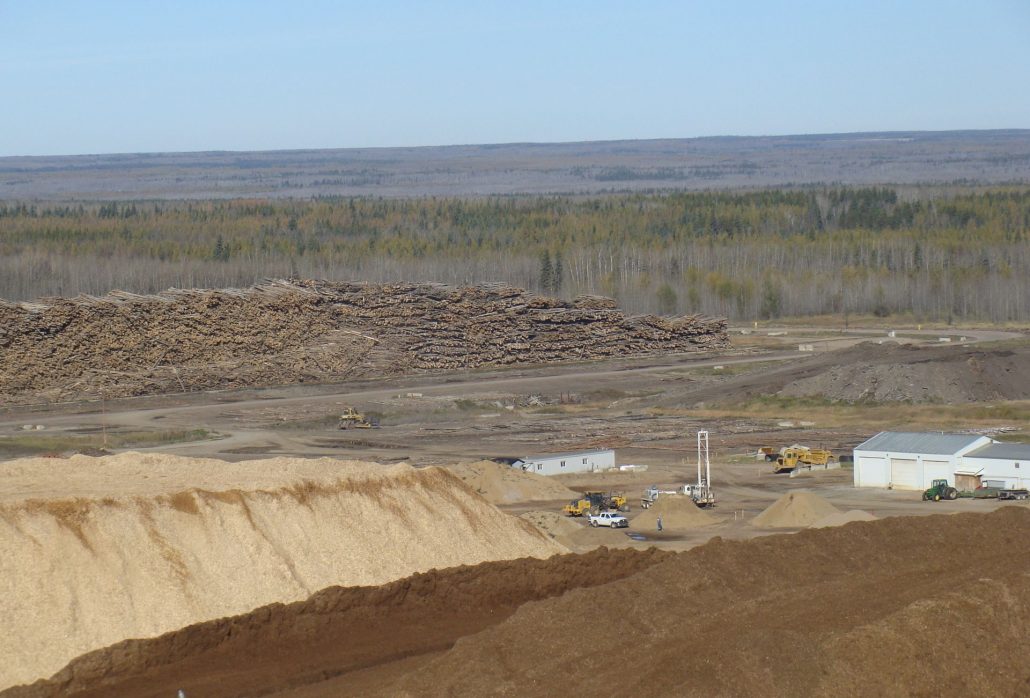
Storage of logs and processed aspen chips at Al Pac pulp mill. Behind you can see endless aspen and birch forests surrounding the mill
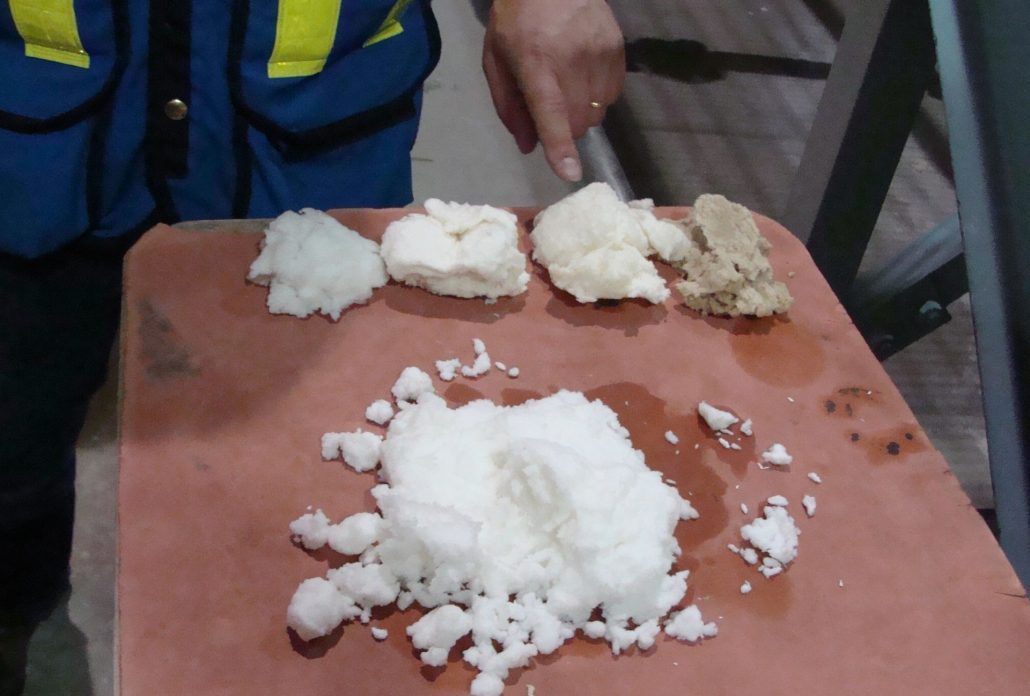
Bleached pulp is one of the finished goods of Al-Pac
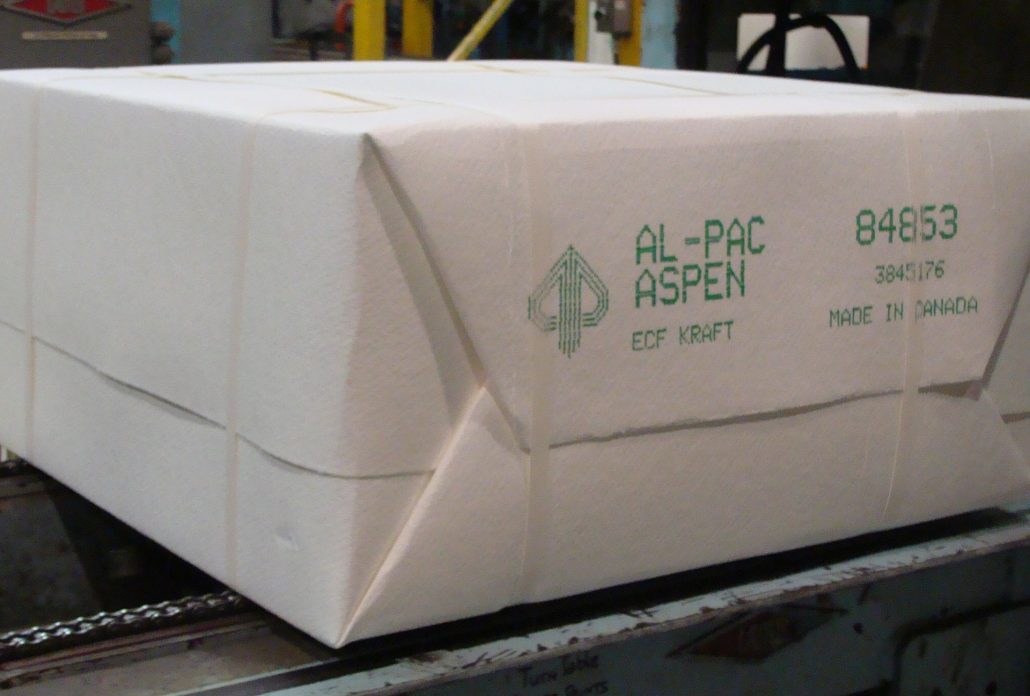
Al-Pac finished goods – packaging cardboard
Another interesting detail of the field tour for the Russian participants was that the main contractors of Al-Pac in this area (Lac La Biche municipality 200 km to the North-East of Edmonton, capital of Alberta) are Russians – people from the Russian Old Believers’ community, who came to Alberta in 1974. To make it happen the members of the community (including previous generations) travelled almost half the globe. Their motherland is Primorye. The ancestors of these people escaped from that place and the Bolsheviks during the Civil War to Brazil via China, and then to the USA (Oregon), and their descendants finally settled in Canada having founded the Berezovka village in Lac La Biche. The community has around 300 people. Some of the community members own equipment, such as harvesters, forwarders, wood trucks, and they operate it with their relatives. Members of the Russian community lead harvesting, hauling and other related operations. The company’s management is satisfied with the cooperation with the Russian community, they value efficiency, honesty and entrepreneurial spirit of those people. Another advantage mentioned by the managers is no alcohol abuse. And the community members in their turn are grateful to the company management for the respect of Old Believers’ traditions and rules, as the company allows them to celebrate all their religious holidays, keep the fast, etc.
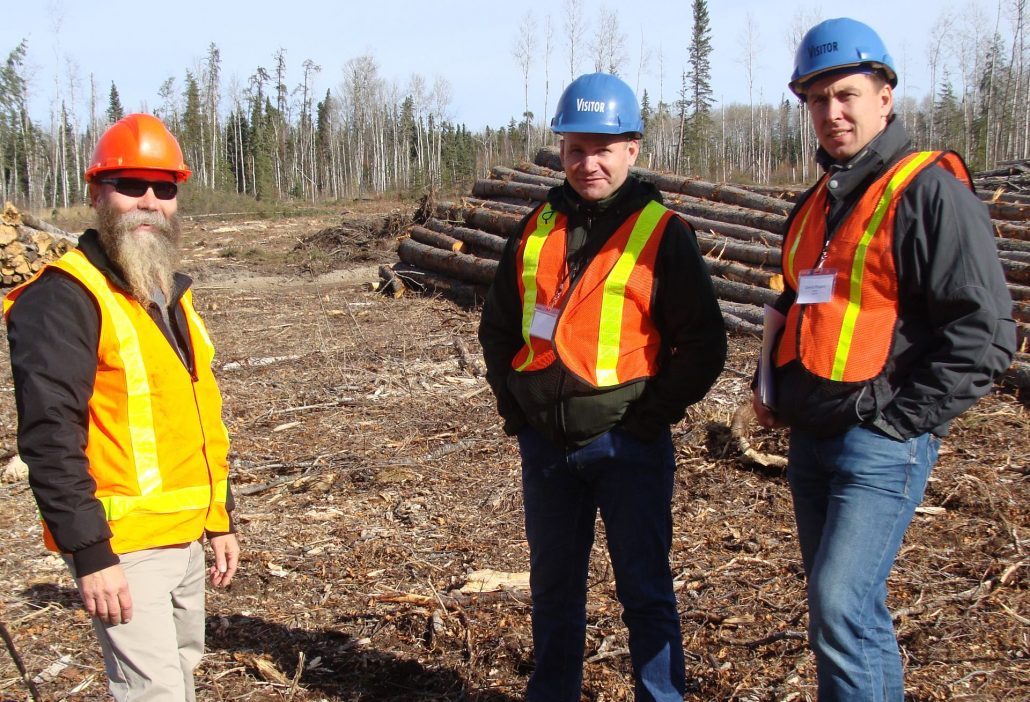
Workshop participants on behalf of Mondi Syktyvkar A. Zaytsev and D.Popov talk to Fedor Martyushev, one of Al Pac’s contractors
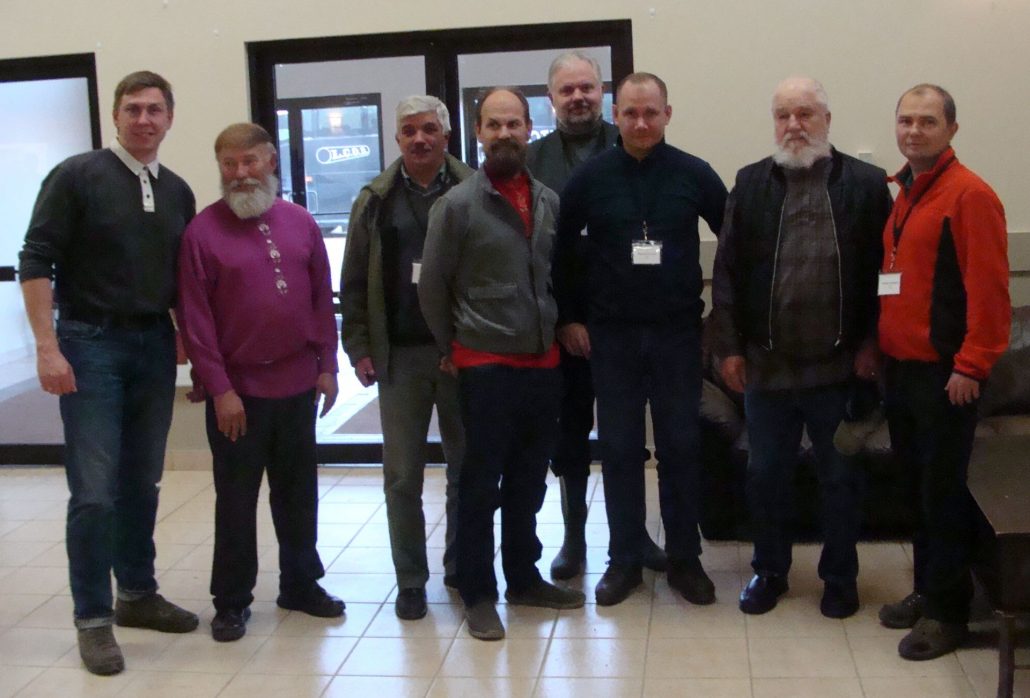
Members of the Russian delegation met Old Believers from Berezovka, Lac La Biche, Alberta
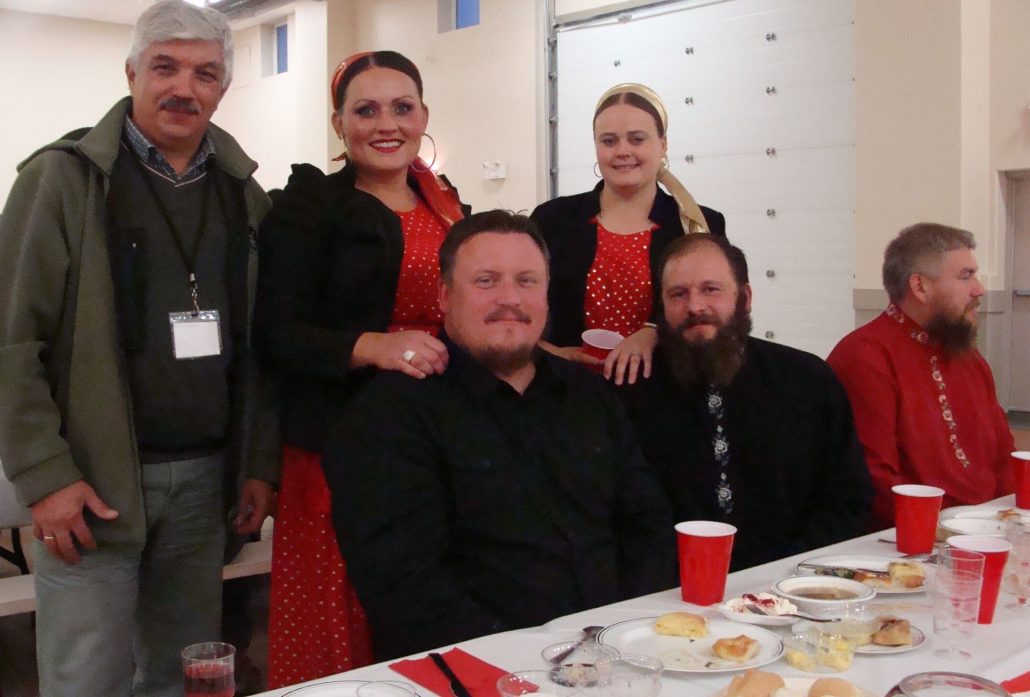
Family traditions are strictly observed in the Old Believers’ community
Although the member of the community have lived for a century away from their motherland and been to different countries surrounded by other cultures and languages, they managed to preserve their language, customs and traditions, culture and faith. In the community settlement Russian is taught together with the official English and French languages.
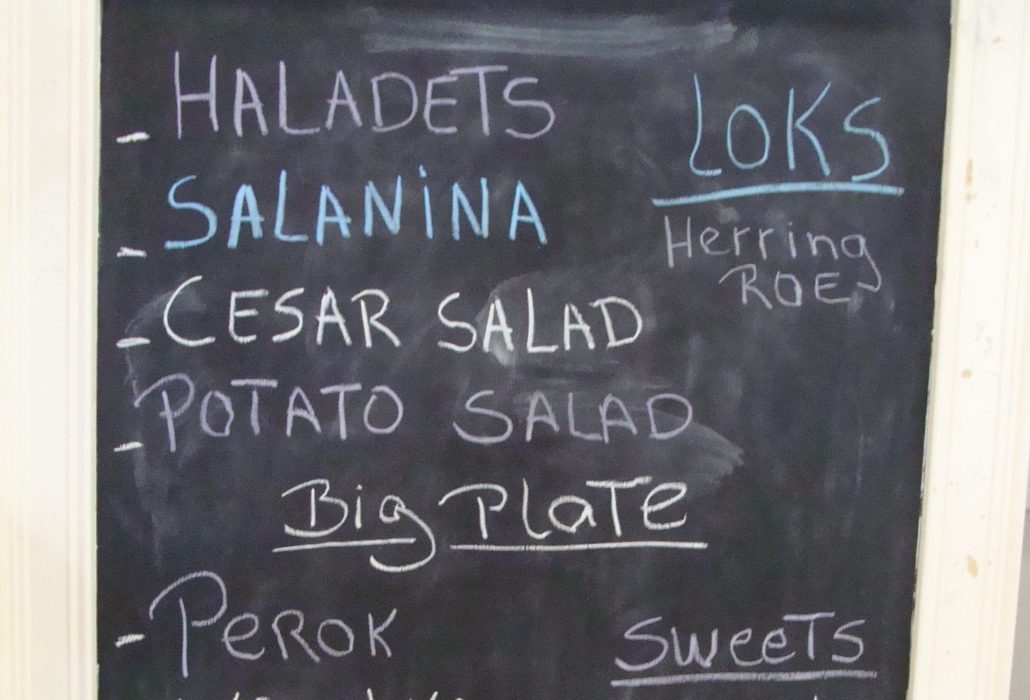
The menu of the festive dinner in the Old Believers’ community: typical Russian dishes – haladets (aspic), salanina (corned beef), perok (pie) — are unusual to be spelled in English
“Even though none of the community members were born in Russia, they all spoke Russia to us,” Yury Pautov says. “And they speak Russian with each other, while English is used to talk to the others. What makes them look differently from other municipality residents is that all men have beards and women wear sarafans. In addition, families of Russian Old Believers are large with many children…
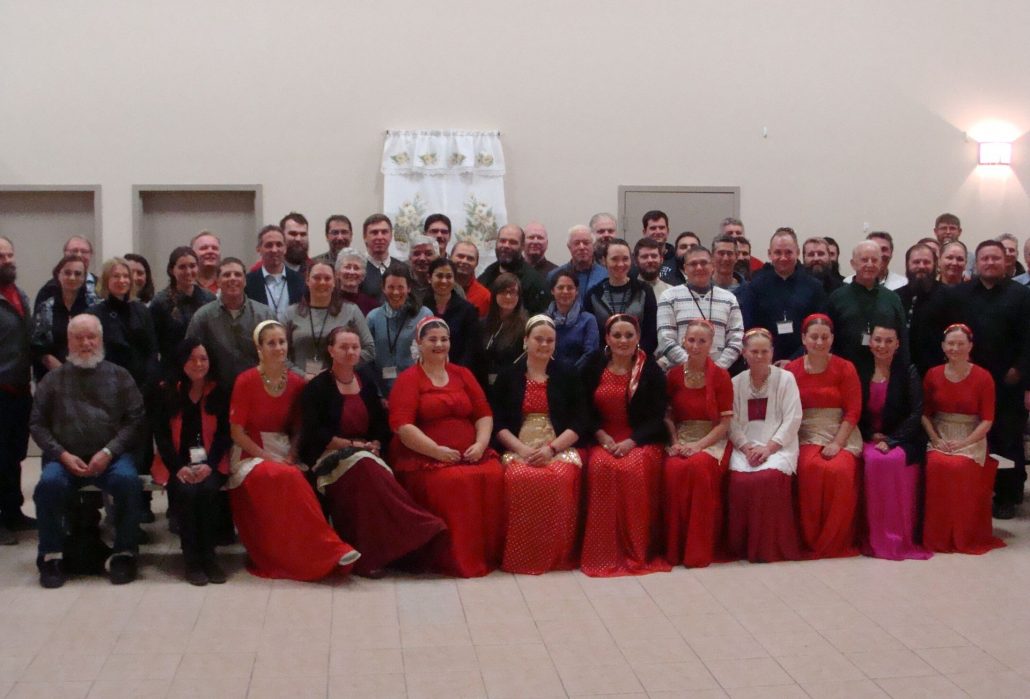
Participants of the field tour at the reception by the Russian Old Believers’ community of Lac La Biche
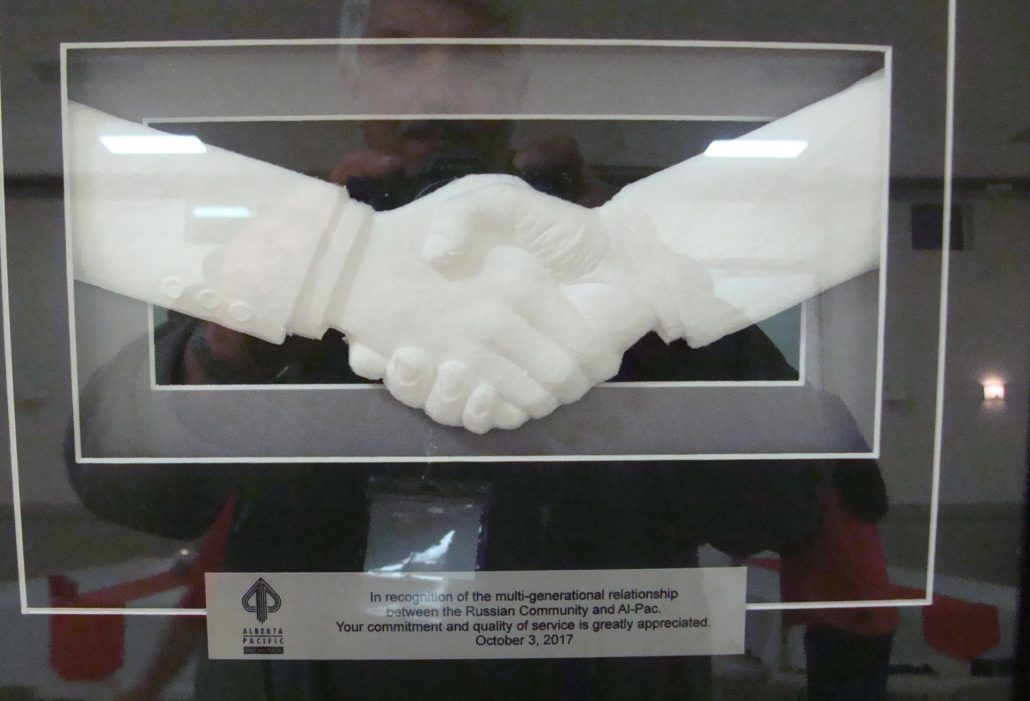
Al Pac’s souvenir for the Russian community. The writing says, “In recognition of the multi-generational relationships between the Russian Community and Al Pac. Your commitment and quality of service is greatly appreciated. 03.10.2017»
According to Yury Pautov, the thorough study of the successful practice of sustainable forestry in Canadian boreal forest, the new information obtained during the trip, and discussions of everything that was seen and heard will help the Russian participants – representatives of FSC certificate holders, international FSC members, environmental NGO representatives and FSC Russia staff – in their sustainable forestry promoting activity.
Residents of Priluzye District Ambitious to Embrace GIS Technologies
| News by Just AuthorThe Silver Taiga Foundation supported by WWF held a working session on Alternatives of Forest Resources and Forest Management Data Acquisition through Earth Remote Sensing in the village of Obyachevo, Priluzye district, at the Priluzye Forestry, on 16-17 October 2017.
Nikolay Shuktomov, forestry projects coordinator, and Alexander Borovlyov, GIS expert, informed the participants of the workshop about the basics of geographic information systems, acquisition and processing of Landsat and Sentinel space images with SAS.Planet, they spoke about practical application of ERS data and how one can use the commonly accessible QGIS geoinformation system, they also showed some functions of the modern cartographic WEB services. A special focus was placed on legal aspects of GIS and ERS data application.
Nikolay Shuktomov is lecturing on ERS data application
All the participants brought their laptops to the workshop. They were provided with the necessary software, and moreover each of them received a workbook developed by the Foundation’s staff for this purpose.
Among 13 participants there were district foresters and engineers of Priluzye Forestry, as well as representatives of the Public Forest Council of Priluzye district. All of them shared the opinion that the facilitators managed to raise the true interest of the audience to up-to-date GIS technologies. It had seemed at first that foresters, who use cartographic data in their work every day, could hardly be impressed with anything, but even they learned a lot for those 2 days. For example, they were trained to convert hard copies of cartographic data to a digital format. At the classes they compared the borderline of logging plots against space image data with the help of GPS navigators, as a result the coordinates matched successfully. Later on, foresters and engineers are planning to use the obtained skills to detect forest fires, identify illegal forest cutting and perform other forest surveying activities.
Social activists dealing with tourist route development and participating in allocation of high conservation value forest areas, such as, for instance, mushroom and berry collection sites, also got some extra skills useful for their work.
“The classes were structured in such a way that theory matched practice, and many of us lacked time to develop the skill. It would be better if more hours were devoted to practical tasks. As soon as I get an opportunity, I’ll sit at my computer to reproduce the whole sequence of actions by myself, but I am not sure that I’ll manage to recall all of them, even though I tried hard to make thorough notes like all other participants. It is great that the workshop was organized within two days; otherwise it would be difficult for the people to find more time to be out of work. Nevertheless, I would like the Foundation’s experts to keep on providing consulting support to the trainees after the session,” Konstantin Serditov, member of the Public Forest Council of Priluzye district, expressed his views.
Workshop participants
“We surely understand that it is impossible to train people to conduct even basic operations within such a short period. To master the technique of GIS application you need much more time. It should be also noted that the audience was very diverse, with different competence levels. We need to be more scrupulous, when we put groups together, they really need to be more homogeneous. Later, we will adjust the curriculum based on the qualification and professions of the participants,” said Nikolay Shuktomov, forestry projects coordinator.
The public activists of Priluzye district suggest conducting similar courses with a similar agenda for activists and foresters of the Letka cluster. The residents of the district center are sure they will also be interested in GIS technologies.
How to Make Money from Aspen
| News by Just AuthorSilver Taiga Foundation’s director Yury Pautov took part in the field tour entitled “Sustainable Forestry – a Dialogue between Canada and other Countries” where experts from Russia and other forested regions learned about the experience of forestry landscape planning at Alberta’s lowland landscapes.
The workshop was held as part of the preparation for the FSC General Assembly that took place from 8 to 13 October in Vancouver, Canada. It was facilitated by FSC Canada and one of the leading North American forestry companies Alberta-Pacific Forest Industries (Al-Pac), as well as by Boreal Forest Platform, an independent platform for free discussion in the field of sustainable forestry, one of initiators of which was the Silver Taiga Foundation.
“To my mind, the workshop was useful both for Russian participants and for representatives of other countries”, Yury Pautov says. “Through observing the way a real FSC certified company operates we saw how you can combine a profitable business with environmental protection and community support in very similar economic and climatic conditions. Аl-Pac leases 7.5 m ha of forested land, with two thirds of it being wetlands and low productive areas. In such conditions there are also no roads, so 75 percent of wood is harvested and hauled in winter, as construction of earth roads at swamps is of no economic benefit. In addition, the biggest part of the leased area is located in the transition zone between boreal softwood forest and prairie dominated by hardwood species, particularly by aspen. And it is aspen that serves as the target species the company focuses on. It is the same aspen as in Russia – low quality, rotten aspen! The average transportation distance is over 200 km. Nevertheless, the company is profitable, it uses up-to-date cutting and road construction technologies. The key product is pulp and ethanol. While softwood species are sold to sawmills…
Young aspen forest at the area which was burnt by the fire 9 years ago
Tigercat harvester can cut and pile several trees at once to facilitate subsequent skidding
Pile of aspen logs ready to be loaded onto trucks
Average transportation distance to the pulp mill is 250 km
According to Yury Pautov, what is known in Russia to be clear cutting isn’t practiced there. Precisely detailed laser ground survey able to register all properties of the landscape is used for forestry planning. Natural history-based “turnover” of forest fires is 60-80 years, according to the company managers. Cutting imitates natural fire dynamics. It is clear that fire doesn’t burn everything, but only the most well drained parts of landscape, so harvesting is planned with this regard. The average size of one logging plot may amount to 2 thousand ha, but only 20-30 percent of the area may be cut. Specially trained teams of delineation experts use space images, aerial photography and laser survey data to draw the borders of the natural fire. Within these borders they mark the boundaries of clear cutting area, plan forest roads and cutting areas adjacent to them, logways, etc. This is necessary, because the mature forest at the area which burnt 60 years ago is similar age. Thus they imitate fire impact by means of logging. At the same time, they preserve biotopes and old trees which remained intact during the last fire for some reasons.
Boundaries of clear cutting areas and their exact GPS coordinates are marked on process sheets and indicated by coloured tape in kind
Workshop participants at the area cut 8 years ago
The landscape in this area is flat and swampy, and even minor lowlands are covered with wetlands, which on the one hand are significant from the biological and environmental points of view, and on the other hand are inefficient for harvesting, so the company takes this feature in account and maintains the hydrological network of the area by building bridge crossings over minor streams and hollows and conserving water protection zones along streams and wetlands.
Temporary bridge crossings over streams and hollows is a mandatory condition for forest cutting
Why is harvesting still cost effective with such an approach to logging planning (when only 20-30 percent of the area is cut and mostly unmarketable aspen is obtained)?
“Canada’s advantage in this case is that the natural use rules, as well as forest use regulations, are defined not on the federal level as in our country, but on the province level,” Yury Pautov answers. “It allows taking all social, economic and landscape properties of the region into account. Moreover, the rent is paid not to the federal center, but to the province government, so it is the local government that defines the rules of lease and cutting. In our country, as is known, the rules of the game are defined by federal officials who fail to understand regional peculiarities, or distinctive features of landscapes of different areas… A forest user is left with no options to apply any justified or rational approach to cutting, which should be different in different situations.
Storage of logs and processed aspen chips at Al Pac pulp mill. Behind you can see endless aspen and birch forests surrounding the mill
Bleached pulp is one of the finished goods of Al-Pac
Al-Pac finished goods – packaging cardboard
Another interesting detail of the field tour for the Russian participants was that the main contractors of Al-Pac in this area (Lac La Biche municipality 200 km to the North-East of Edmonton, capital of Alberta) are Russians – people from the Russian Old Believers’ community, who came to Alberta in 1974. To make it happen the members of the community (including previous generations) travelled almost half the globe. Their motherland is Primorye. The ancestors of these people escaped from that place and the Bolsheviks during the Civil War to Brazil via China, and then to the USA (Oregon), and their descendants finally settled in Canada having founded the Berezovka village in Lac La Biche. The community has around 300 people. Some of the community members own equipment, such as harvesters, forwarders, wood trucks, and they operate it with their relatives. Members of the Russian community lead harvesting, hauling and other related operations. The company’s management is satisfied with the cooperation with the Russian community, they value efficiency, honesty and entrepreneurial spirit of those people. Another advantage mentioned by the managers is no alcohol abuse. And the community members in their turn are grateful to the company management for the respect of Old Believers’ traditions and rules, as the company allows them to celebrate all their religious holidays, keep the fast, etc.
Workshop participants on behalf of Mondi Syktyvkar A. Zaytsev and D.Popov talk to Fedor Martyushev, one of Al Pac’s contractors
Members of the Russian delegation met Old Believers from Berezovka, Lac La Biche, Alberta
Family traditions are strictly observed in the Old Believers’ community
Although the member of the community have lived for a century away from their motherland and been to different countries surrounded by other cultures and languages, they managed to preserve their language, customs and traditions, culture and faith. In the community settlement Russian is taught together with the official English and French languages.
The menu of the festive dinner in the Old Believers’ community: typical Russian dishes – haladets (aspic), salanina (corned beef), perok (pie) — are unusual to be spelled in English
“Even though none of the community members were born in Russia, they all spoke Russia to us,” Yury Pautov says. “And they speak Russian with each other, while English is used to talk to the others. What makes them look differently from other municipality residents is that all men have beards and women wear sarafans. In addition, families of Russian Old Believers are large with many children…
Participants of the field tour at the reception by the Russian Old Believers’ community of Lac La Biche
Al Pac’s souvenir for the Russian community. The writing says, “In recognition of the multi-generational relationships between the Russian Community and Al Pac. Your commitment and quality of service is greatly appreciated. 03.10.2017»
According to Yury Pautov, the thorough study of the successful practice of sustainable forestry in Canadian boreal forest, the new information obtained during the trip, and discussions of everything that was seen and heard will help the Russian participants – representatives of FSC certificate holders, international FSC members, environmental NGO representatives and FSC Russia staff – in their sustainable forestry promoting activity.
SILVER TAIGA FOUNDATION HAS TAKEN PART IN FSC GENERAL ASSEMBLY
| News by Just AuthorThe Silver Taiga Foundation joined the international FSC membership in February 2017. The Forest Stewardship Council (FSC) is a non-profit non-governmental organization aiming at promotion of a responsible forest management all over the world. Silver Taiga Director Yury Pautov took part in FSC General Assembly, held in Vancouver (British Columbia, Canada) on October 8-13.
FSC General Assembly is a supreme body of the given international NGO, which determines the area of FSC-certification development for the nearest three years.
– More than 800 people from almost all over the world took part in the event, – says Yury Pautov. – During 5 days the delegates discussed the FSC development strategy for the period of 20 years, its implementation plans for the nearest three years and the organization management system. During the last two days the participants listened to the board of directors and the FSC secretariat reports, discussed the draft Resolutions prepared by the participants from different countries and voted for them. As the result 15 draft Resolutions were approved out of 70 ones, which mostly specify and enlarge the previously approved by the members the FSC strategic development plan.
Members of FSC Board of Directors
Only 1 out of approved 15 Resolutions can be regarded as a new one and it cannot be related to the Russian certificate holders as it deals with the certification of the plantations in case if they are planted in the wooded lands after 1994 and in compliance with a set of conditions.
Andrey Ptichnikov is being awarded for FSC certification development in the CIS states
All other Resolutions approved by the General Assembly 2017 clarify or enlarge already existing principles, criteria or previous FSC documents. They are, for example, the Resolution concerning the implementation of FPIC (free preliminary informed consent) strategy in cooperation with the indigenous and local communities or the Resolution focused on the stepped-up contribution to the food and non-wood forest resources certification and some others…
The report of the FSC Director General Kim Carstensen
According to Yury Pautov the Russain delegation took an active part in all sections of the given forum. In particular the Russian participants presented 5 draft Resolutions (the use of a landscape approach to the intact forests zoning, the mapping of the certified companies borders and others), but neither of them won the majority of votes.
The Russian delegation in the FSC General Assembly 2017
It should be noted, that participation in the General Assembly is important not only for Resolutions approval. It also gives an opportunity to discuss different problematic points, to make new contacts, to consult the colleagues from other regions and countries, to get an interesting and useful information. The Russian participants of the FSC General Assembly 2017 used these opportunities as much as possible.
Welcome to the FSC General Assembly 2017 from the local Indians
Following the Mezen Salmon
| «Model river «Mezen» project by Just AuthorThis autumn once again the Silver Taiga representatives together with the specialists of Udora branch of Komirubvod State Budgetary Institution and Protected Areas Republican Center have carried out an expedition to the upper reaches of the Mezen River (including its tributaries Upper and Lower Puzla), Elva Mezenskaya and Pyssa. The aim of a week-long tour (October 1 – 8) was to monitor the Atlantic salmon spawning grounds under Model River Mezen project. The monitoring at the given area is being conducted since 2011.
The total route distance is about 200 km long. The expeditions are usually held in the beginning of October as the salmon spawning season starts in autumn from the middle of September and lasts until the freezing up of rivers.
The total route distance is about 200 km long
The spawning usually happens on the shallows with a sand-and-shingle and nonsilted up bottom. New salmon redds counting data got during the expedition compared with the data of the previous years will help to conclude about the changes in the state of the commercially important fish population. The monitoring of the spawning ground state and fullness is one of the population dynamics estimation methods. According to the data of the previous years, the salmon stock in the Mezen River is tragically decreasing from one year to another. The data recorded during the expedition will be clarified and analyzed, though, according to the leader of the expedition the Model River Mezen project coordinator Nikolay Shilov, the situation has not changed in comparison to the previous year.
– According to preliminary calculations, the number of redds in the headwater of Mezen River has decreased and in Pyssa and Elva Rivers has insignificantly increased. Notwithstanding that the water is colder than usual and the water level is comparatively high (these factors quicken and facilitate the spawning), the redds are met very seldom, – highlights N. Shilov.
At the bottom
Drift samples collection
The drift samples (the main ration ingredient of young salmon) were also selected during the expedition in one of the remote parts of Puzla River. The data got during the expedition will be processed during the laboratory examination and then included into the justification of a purpose-oriented interregional program on Mezen salmon conservation and reproduction in Komi and Arkhangelsk regions. The program is being elaborated under Model River Mezen project at the initiative of Silver Taiga Foundation.
Bearded stone loach lair
Udora golden autumn
Photos by Nikolay Shilov
Syktyvdin Schoolchildren Took on Roles of FSC Certification Participants
| News by Just AuthorAccording to the well-established tradition initiated by the Forest Stewardship Council (FSC) educational actions aimed at forest preservation and regeneration, as well as sustainable forest management, are held each year on the last Friday of September in many countries of the world. On that day experts share their knowledge on the way forest certification contributes to responsible forest management and supports the rights of the future generations to use forest resources. People from different corners of the world are reminded that forest is more than just a source of wood for people’s needs; it is also the basis for social and cultural uniqueness of local forest communities. The day saturated with responsible forestry promotion events is known as FSC Friday. This year, Silver Taiga Foundation for Sustainable Development also joined the celebration of responsible forestry.
The FSC Friday was combined with the tour of the health improvement Pine Forest path near Krasnozatonsky, so it wasn’t held on the last Friday of September, but on October 13. The informational tour was arranged by the Association of Foresters of the Komi Republic. Senior schoolchildren told the youngsters from Syktyvkar school forestry (Vylgort secondary school) and Syktyvdin school forestry (Pazhga secondary school) about the character of the pine forest ecosystem.
At the beginning of the tour
Schoolchildren are speaking about pine forest ecosystem
At one of the ecological tour stations
Deputy director of the Silver Taiga Foundation for Sustainable Development Valentina Semyashkina spoke with the students about multifunctional nature of forests and a great variety of stakeholders. Thus, the kids were brought to the conclusion that it was necessary to consider different, even contradictory at times interests to ensure sustainable and responsible forest management. Then, Silver Taiga’s staff moved on to the objectives of FSC forest certification, and after the children were briefly informed on its principles, they were invited to take part in a role game.
Silver Taiga Deputy Director Valentina Semyashkina
The role game introducing social aspects of the FSC certification to the kids and facilitated by Ms. Semyashkina became the most entertaining part of the day.
The game was based on a real case with a conflict in Keres, Kortkeros district, in 2012. At that time residents of the village were dissatisfied with one of the logging companies which managed some leased area in the south of Keres. Local residents were against cutting in the forest area which had always served as a place for collecting mushrooms and berries and laying hunting trails.
The participants of the role game were divided into seven groups representing a logging company, environmentalists, scientists, local residents, hunters and fishers, tourists interested in the region, and municipal authorities… After a short discussion within the group each of them had to announce and defend their interests with a purpose to convince other stakeholders. It was notable that the game revealed the same arguments and demonstrated the same situation as occurred in the real situation. Finally, the parties came to a compromise and managed to meet the interests of the business and locals – they decided to conduct selective cutting and preserve the most valuable for people parts of the forest.
“The hunters” are intent on defending their “trails”
“The scientists” are preparing their arguments against clear cutting
“We are cutting legally”, – “the logging operators” are saying
“The logging companies” are promising to plant the trees after cutting
When the game was over, the schoolchildren were offered sweets, while the most active participants were awarded with some prizes. To memorize the occasion, the students of Krasny Zaton secondary school put the stone of friendship near the campfire place of the health improvement path, and invited kids from other schools to do the same.
Participants of International Conference Appreciated Experience of Mezen Salmon Spawning Grounds Monitoring
| News by Just AuthorThe international conference “Salmonids: Biology, Preservation and Restoration” held in Petrozavodsk at the end of September was attended by Nikolay Shilov, coordinator of the Model River Mezen project.
“It was a scientific conference with most of reporters presenting the data and results of their fundamental studies to the participants”, Nikolay says. “However, there were quite a lot of reports focusing on various practical methods of managing such a valuable resource as the salmonids. Not only academicians participated in that important event, some practical experts and representatives of NGOs dealing with preservation and restoration of the salmonid fishes also did. For example, Valery Irkashev, who represented the recently founded Murmansk Salmon foundation, presented a report on the strategy of preservation of the Atlantic Salmon populations in Russia, where he provided some clear suggestions on amending the legislation, recommendations on preservation activities, etc. Now, the foundation’s experts are testing various salmon population monitoring methods and trying to develop public protection and control.
According to Nikolay Shilov, most authors of salmon monitoring reports used the data related to marine and industrial fishing, very few of them conducted their research on rivers. For example, monitoring of spawning grounds was highlighted in the report by Aleksey Veselov, Doctor of Science from the Institute of Biology, Karelia Scientific Center, RAS, who studies distinctive features of location of redds at spawning grounds.
Nikolay Shilov’s presentation on the first results of the method of Atlantic Salmon nests accounting in the Mezen river raised a lot of interest in the audience, especially among fishery experts and application scientists. The method was also attractive due to its low cost and no need for any special permits. However, different participants of the conference saw the method and experience under the Model River Mezen project differently. There were quite a few questions mostly about estimation of the method error.
“We do understand ourselves that it is wrong to use this method as the core one without the method error being assessed”, Nikolay Shilov highlights. “And I managed to make some preliminary agreements for some Karelia experts to participate in our project to fine-tune the method with the help of other methods (by means of fish counting fences or hydroacoustic devices). Actually, the biggest advantage of our participation in the conference is new contacts with specialists which will be good for our further work under the project. And of course, presentation of our method and experience to the wide professional public and receiving of feedback and assessment. In the coming year we will fine-tune and estimate the method error and next year we will be able to submit the method for approval to the Polar Research Institute of Marine Fisheries and Oceanography (PINRO).
The photo is taken from veterinary.gov-murman.ru
Kids with Mums and Dads Invented Fairy-Tales, Drew Fishes, Made Videos and Compiled Mezen Guides
| «Model river «Mezen» project by Just AuthorThe interregional environmental Family Battle contest launched on 1 September, initiated and conducted by the Leshukonye Central Library (Arkhangelsk region) as part of the Model River Mezen project, is completed.
The family teams that applied for the contest had to travel “distantly” along the Mezen river from its source to the estuary by performing environmental tasks. Each task fulfilled correctly earned points for the teams. The teams with most of the points competed in the final – at the “estuary” of the river. Families from Leshukonye, Mezen and Udora districts were invited to participate in the competition. 6 teams were admitted for the start, 5 from Leshukonye and one from Udora. Four teams got to the final – Joyous Family, Girls and Cactus from Leshukonye district and Udorachi from Udora district.
The game consisted of 5 stages. At the first one the participants had to invent a fairy-tale, story or legend about how the Mezen river appeared, and the children had to illustrate their essays. At the second stage the participants had to make a video with the youngest family member reciting a poem about the Mezen river. At the following stages they had to compile and present a quiz devoted to the Mezen and do the quiz prepared by another family.
The final test was creation of a tourist guide of the district chosen at random (either Leshukonye, or Mezen, or Udora districts). In addition, the children had to draw fishes inhabiting the Mezen river.
All tasks were assessed by a jury made of four people. According to the jury, the participants took a creative approach to fulfilling the tasks, they did it with all their hearts, all their works turned out to be bright and interesting. However, it was a competition, so the winner certificate and the prize went to the Joyous Family team – Anna Ivanova and Maxim Ivanov from Leshukonskoye – with 85 points they had earned. Our congratulations on the victory! The other teams were awarded participant certificates and souvenirs.
“We are thankful to all the participants”, Svetlana Ivanova, the contest facilitator, said. “Thank you very much for finding time to participate in our initiative. A special “thanks” is to the Udorachi team from the Republic of Komi – Alyona Tsyngina, Bogdana Tsyngina and other members of their big family.
It should be noted that the Leshukonye Central Library staff joined actively the Silver Taiga’s project on sustainable fishery resources management in cooperation with the local population (Model River Mezen) and conducted a cycle of environmental training events entitled as Mezen – River of the North, River of Life in June-September. The environmental Family Battle is just one of such events.
Family Battle winners Anna and Maxim Ivanovs
I Live at the Mezen Bank
| «Model river «Mezen» project by Just AuthorThat was the name of the photo contest organized by the Leshukonye Central Library staff under the environmental and educational project Mezen – River of the North, River of Life with the support of the Silver Taiga Foundation (Model River Mezen project).
Residents of the Mezen districts of Arkhangelsk region and the Komi Republic were invited to participate. The photos were accepted for two nominations: Beauty of the Native Village and Beauty of the Dear River. The pictures submitted for the contest were displayed at the Leshukonye Central Library and the readers were offered to judge them and to vote for the best works.
Photo show
“Residents of Leshukonye and Udora districts took part in the district”, Svetlana Ivanova says. “Mezen district residents haven’t sent a single photo unfortunately. 34 pictures were registered for the two nominations. 129 readers took part in the independent assessment. The readers’ choice for the Beauty of the Native Village nomination was the photo Beauty of Malaya Pyssa by Alyona Tsyngina. This photo got maximum votes – 57 in total.
«The beauty of Malaya Pyssa village» (author A. Tsyngina)
The second place was given to the Rodoma Village photo by Albert Loginov from Udora district (Malaya Pyssa).
«Rodoma village» (author A. Loginov)
The work called We Don’t Need Foreign Resorts by Natalia Fedotova from Yuroma, Leshukonye district, became the third.
N. Phedotova from Yuroma (the 3rd place)
«We don’t need foreign resorts» (author N. Phedotova)
The winner of the Beauty of the Dear River nomination was the work by Albert Loginov – The Kama River – the Mezen Tributary.
«The Kama River – the Mezen Tributary» (author A. Loginov)
The second place was given to Valentina Semenova with her Autumn Landscape (Tsenogora, Leshukonye district).
«Autumn landscape» (author V. Semenova)
And the third place was taken by Elena Novikova from Leshukonskoye with her photo Mirror.
«Mirrorlike surface» (author E. Novikova)
And only four works (three from Leshukonye district and one from Udora district) took part in the art contest 7 Wonders of the Mezen River. The first prize was unanimously given to Alyona Tsyngina from Koslan and her Udora Necklace presentation.
All participants of the contests were awarded with certificates and thank-you letters, presents and souvenirs at the gala evening devoted to the Mezen river, were competing works were displayed, extracts from literary works were recited, and local poets from the Vashka literary association declaimed their poems.
The facilitators are grateful to participants of both contests and hope for active participation of readers in new initiatives of the library. Special gratitude of the Leshukonye Central Library is to the Central Library named after A. Vaneyev in Koslan, Komi Republic, for support in contest organization.
The presents are going to be sent to Komi
You can see other participating photos at https://vk.com/album-37769424_246537242
New Wildlife Reserve in Udora Will Help Unite Protected Natural Areas of the Komi Republic and Arkhangelsk Region
| News, «High Conservation Value Forests» project by Just AuthorThe initiative related to the new complex landscape reserve in Udora district known as the Osa reserve (project title) was reported by Yury Pautov, director of the Silver Taiga Foundation for Sustainable Development, at the territorial conference for nomination of candidates for the V All-Russia Environmental Meeting held in the Institute of Biology, Komi Scientific Center of the Ural Branch of the RAS on 28 September, 2017.
The “project” title of the reserve is derived from the Osa river (the Vashka tributary) flowing along Udora district. The reserve is planned to be founded at the Verkhnyaya Vashka forestry at the border between the Komi Republic and Arkhangelsk region. The foundation of this specially protected area has been in progress since 2004. Based on the results of the physical accounting of virgin natural areas at the Verkhne-Vashka intact area the most valuable from the environmental point of view part – its Core, located both in the Komi Republic and Arkhangelsk Region – was found. In 2015, the Uftyuga-Ilesha landscape reserve was arranged in the Arkhangelsk part of the Core.
In 2016, the Silver Taiga Foundation organized an expedition to justify the environmental integrity and borderline of the new protected area in the Komi part of the Core of the Verkhne-Vashka Intact Forest Massif. Its participants were both the Foundation’s staff and the scientists of the Komi Scientific Center of the Ural Branch of the RAS, as well as environmental experts from St. Petersburg, Moscow, Arkhangelsk and Finland. The participants of the expedition walked over 250 km routes, found over 25 species of rare and endangered species of plants, fungi, and lichen from the Red Book of Russia and the Red Book of the Komi Republic. In addition, there you can find the habitat of the most southern population of the wild reindeer in the Russian North.
The design area of the reserve amounts to 74 thousand hectares. The area of the reserve to-be includes the famous Korabelnaya Chashcha described by the well-known Russian writer Mikhail Prishvin, and is adjacent to the existing Verkhne-Vashka and Uftyuga-Ilesha reserves.
The map of the Reserve
At present, almost the whole area planned for the reserve is leased by forest users. As Yury Pautov underlined in his report, the intact massif borders clear cutting areas both in Arkhangelsk region and in the Komi Republic. However, its most precious Core is still preserved.
“The reserve is valued as it unites the existing specially protected natural areas of the Komi Republic and Arkhangelsk region into a huge cluster and allows conserving the Core of the intact area. Such huge intact taiga areas are most resistant to various natural disasters, such as fires, windfalls or climate change. In such areas you can find swamps, lichen communities, spruce and pine forests. Large areas are able to preserve their population and genetic diversity for a very long time”, the reporter noted.
In addition, the area concentrates model intact catchment areas and sources of such rivers as the Osa, Poch, Ilesha, Uftyuga flowing into the Vashka and Vychegda in the Komi Republic and into the Pinega in Arkhangelsk region.
The economic and environmental justification for the reserve prepared by the Silver Taiga was submitted to be approved to the Ministry of Industry of the Komi Republic and to the subordinate authority – Protected Areas Center. In November, public hearings are planned to be held in Udora district. Then, the documentation prepared is to pass through the state environmental assessment followed by development of the respective regulation. If the documents are approved, the Osa reserve will become the 24th protected area of Udora district.
The participants of the territorial conference for nomination of candidates for the V All-Russia Environmental Meeting
Heads of School Forestry Units Were Told About Methods of GIS-Technologies Application in Ecomonitoring
| News by Just AuthorSilver Taiga representatives took part in the workshop for the heads of the school forestry units held on September 22 under the republican school forestry units meeting at the premises of the republican centre of the ecological education under the support of the forestry specialists’ society of Komi. The Ministry of Education and the Ministry of Industry of Komi were the founders of the meeting.
The school forestry units usually meet once a year. The aim of the meeting is to involve the children and young people to the environmental and exploratory activities. This year the representatives of 12 school forestry units of Komi came to Syktyvkar. Each team consisted of 4 participants – three schoolchildren and one teacher.
Young foresters from five districts of Komi participated in such contest games as Forestry, Forest Protection, Forest Regeneration and Forest Searchers. As for the heads of the school forestry units they listened to the lecture on the use of the cartographical materials in the learning process. The Silver Taiga GIS-specialist Alexander Borovlev told about the geoinformation systems practiced by the Silver Taiga Foundation. The school teachers learned how to use the modern monitoring methods during planning of loggings and how it is possible to control the forest ecosystems changes with the help of the remote sensing data.
«The modern GIS directions have a simple interface. There are the programs available even for theschoolchildren. The very simple set of functions allows using such programs during the forest ecosystems monitoring without any special education. It would be nice to practice the use of the geoinformation technologies during the environmental lessons at school. No doubt, not all the schoolchildren will be the foresters in future, but they should know how to conduct the forest ecosystems monitoring with the help of simple, available-for-all tools», says Alexander Borovlev.
Aleksandr Borovlev